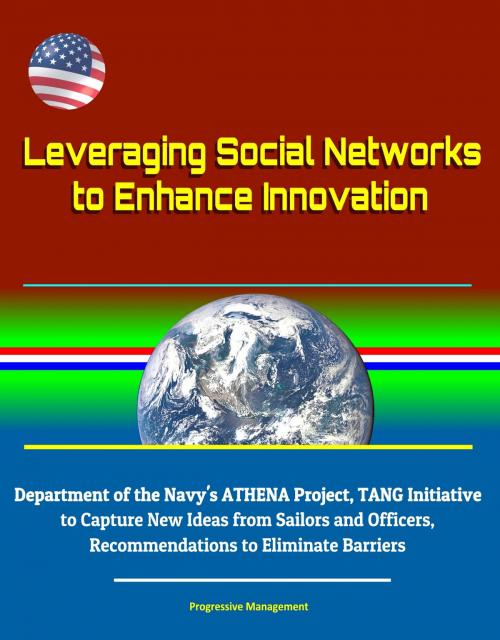Leveraging Social Networks to Enhance Innovation: Department of the Navy's ATHENA Project, TANG Initiative to Capture New Ideas from Sailors and Officers, Recommendations to Eliminate Barriers
Nonfiction, History, Military, Naval, United States| Author: | Progressive Management | ISBN: | 9780463325414 |
| Publisher: | Progressive Management | Publication: | June 13, 2018 |
| Imprint: | Smashwords Edition | Language: | English |
| Author: | Progressive Management |
| ISBN: | 9780463325414 |
| Publisher: | Progressive Management |
| Publication: | June 13, 2018 |
| Imprint: | Smashwords Edition |
| Language: | English |
This important 2018 report has been professionally converted for accurate flowing-text e-book format reproduction.
This study explores the Department of the Navy's innovation initiatives to determine how to leverage social networks to enhance innovation inside the Navy. Using the results of a social network analysis that mapped and measured the informal Navy Innovation Network, and examining how other military branches and industry pursue innovation, this qualitative research seeks to identify gaps and redundancies in the current Navy Innovation Network. Furthermore, recommendations are proposed that provide a more effective and structured approach to capturing innovative ideas from Sailors and Marines to improve Department of Navy operations and policies.
The following two research questions will be addressed within the context of the Navy Innovation Network:
How can the Navy more effectively bridge together individuals and clusters within the social network of Navy innovators? What process improvements can be made to encourage wider participation in the Navy Innovation Network by providing a clear pathway to implement change?
I. INTRODUCTION * A. BACKGROUND * B. PREVIOUS RELATED RESEARCH * C. PROBLEM STATEMENT * D. PURPOSE STATEMENT * E. RESEARCH QUESTIONS * F. RESEARCH METHOD, PROPOSED DATA, OBSERVATION, AND ANALYSIS METHODS * G. POTENTIAL BENEFITS AND LIMITATIONS * II. LITERATURE REVIEW * A. SOCIAL NODES, TIES, AND THE TYPES OF NETWORKS * B. INFORMAL NETWORKS * 1. Issues with Informal Networks * C. PSYCHOLOGY * D. PREVIOUS RESEARCH * 1. Project ATHENA * 2. TANG Forum * 3. USCG's Innovation Program * III. METHODOLOGY * A. EXPLORATORY RESEARCH * IV. ANALYSIS * A. COMMON POSITIVE TRAITS * 1. Team Organization (Flat Hierarchical Structures) * 2. Voluntary Participation * 3. Design Thinking * B. COMMON NEGATIVE TRAITS AND BARRIERS * 1. Vertical Hierarchical Structures * 2. Bureaucratic Issues * 3. Idea Submittal Avenues * 4. Overwork * C. OVERCOMING OBSTACLES * 1. Involve/get Buy-in from the "Middle" * 2. Respecting the Inventor(s) * V. RECOMMENDATIONS AND CONCLUSION * A. THE ICARS SYSTEM * B. THE PROCESS AND STRUCTURE: INNOVATION TEAMS AND PHYSICAL HUBS * 1. Innovation Hunters * 2. Primary Reviewers * 3. Innovation / Executive Council * 4. Locations * 5. Hierarchy * C. ICARS APP * 1. Access * 2. Tracking and Statistics * 3. Opening Screens * D. SUBMISSION COMMUNICATION PATH * E. COMPONENTS * 1. Historical Library * 2. Innovation Database * 3. Fleet and Industry SMEs * F. CONCLUSION * 1. Recommendations and Future Research
This important 2018 report has been professionally converted for accurate flowing-text e-book format reproduction.
This study explores the Department of the Navy's innovation initiatives to determine how to leverage social networks to enhance innovation inside the Navy. Using the results of a social network analysis that mapped and measured the informal Navy Innovation Network, and examining how other military branches and industry pursue innovation, this qualitative research seeks to identify gaps and redundancies in the current Navy Innovation Network. Furthermore, recommendations are proposed that provide a more effective and structured approach to capturing innovative ideas from Sailors and Marines to improve Department of Navy operations and policies.
The following two research questions will be addressed within the context of the Navy Innovation Network:
How can the Navy more effectively bridge together individuals and clusters within the social network of Navy innovators? What process improvements can be made to encourage wider participation in the Navy Innovation Network by providing a clear pathway to implement change?
I. INTRODUCTION * A. BACKGROUND * B. PREVIOUS RELATED RESEARCH * C. PROBLEM STATEMENT * D. PURPOSE STATEMENT * E. RESEARCH QUESTIONS * F. RESEARCH METHOD, PROPOSED DATA, OBSERVATION, AND ANALYSIS METHODS * G. POTENTIAL BENEFITS AND LIMITATIONS * II. LITERATURE REVIEW * A. SOCIAL NODES, TIES, AND THE TYPES OF NETWORKS * B. INFORMAL NETWORKS * 1. Issues with Informal Networks * C. PSYCHOLOGY * D. PREVIOUS RESEARCH * 1. Project ATHENA * 2. TANG Forum * 3. USCG's Innovation Program * III. METHODOLOGY * A. EXPLORATORY RESEARCH * IV. ANALYSIS * A. COMMON POSITIVE TRAITS * 1. Team Organization (Flat Hierarchical Structures) * 2. Voluntary Participation * 3. Design Thinking * B. COMMON NEGATIVE TRAITS AND BARRIERS * 1. Vertical Hierarchical Structures * 2. Bureaucratic Issues * 3. Idea Submittal Avenues * 4. Overwork * C. OVERCOMING OBSTACLES * 1. Involve/get Buy-in from the "Middle" * 2. Respecting the Inventor(s) * V. RECOMMENDATIONS AND CONCLUSION * A. THE ICARS SYSTEM * B. THE PROCESS AND STRUCTURE: INNOVATION TEAMS AND PHYSICAL HUBS * 1. Innovation Hunters * 2. Primary Reviewers * 3. Innovation / Executive Council * 4. Locations * 5. Hierarchy * C. ICARS APP * 1. Access * 2. Tracking and Statistics * 3. Opening Screens * D. SUBMISSION COMMUNICATION PATH * E. COMPONENTS * 1. Historical Library * 2. Innovation Database * 3. Fleet and Industry SMEs * F. CONCLUSION * 1. Recommendations and Future Research















